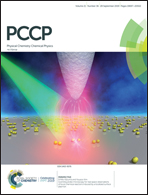An Au22(L8)6 nanocluster with in situ uncoordinated Au as a highly active catalyst for O2 activation and CO oxidation†
Abstract
Ligand-capped gold nanoclusters with atomic precision have attracted great interest as a new type of nanocatalyst to elucidate mechanisms and establish structure–reactivity correlations. In most cases, however, the catalytic activity of fully protected gold nanoclusters is severely hindered due to the blocking effects of the ligands. Alternatively, partially protected gold nanoclusters with the creation of in situ coordination unsaturated (cus) Au are highly promising for nanocatalysis. In this study, via density functional theory (DFT) calculations, we investigated the reactivity of a diphosphine-protected Au22(L8)6 nanocluster using oxygen activation and CO oxidation as the testing probes. The results showed that the cus Au at the interface shows strong adsorption and activation of oxygen, promoting the dissociation of two O2 molecules into fully oxidized Au22(L8)6O4 nanoclusters with a moderate activation barrier (0.6–0.7 eV). The adsorption of additional O2 prefers molecular adsorption and locates at the terminal Au11 unit around the Au–P framework. Furthermore, our results indicate that the Au22(L8)6 cluster shows very high activity and a low energy barrier (0.51 eV) for CO oxidation. The facile O2 activation and CO oxidation over the Au22(L8)6 nanocatalyst will aid the rational design of partially protected metal nanoclusters with coordination unsaturated metal centers in oxidation or other catalytic reactions for important practical applications.



 Please wait while we load your content...
Please wait while we load your content...